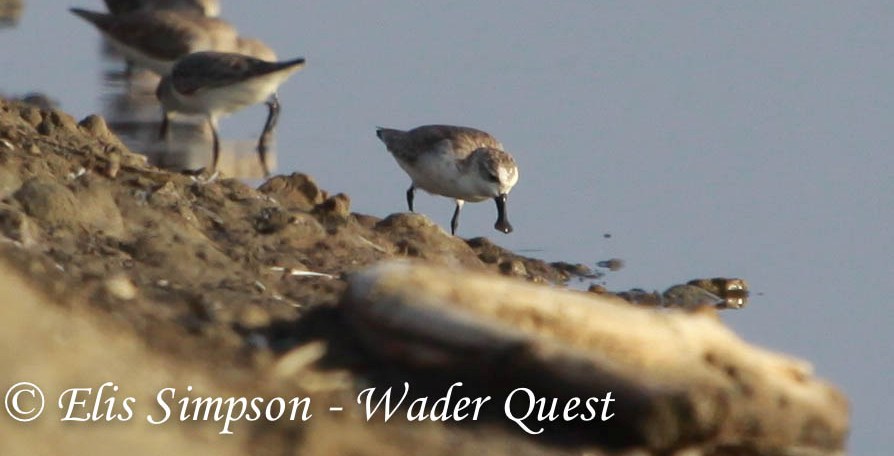Within months of taking over this conservation charity, I realized that world was indeed beyond House Sparrows. I had tried to lend my humble support over past few years to these birds, learning from colleagues that it was on decline in several metro cities, and Jaipur was toeing the line. Our group, TRIMURTY not only adopted nest boxes to step up recruitment but also gifted away a few thousand of them to citizens to make them aware of what they need to do. In all my presentations at Builders’ groups and also at CII, I always issue a mild warning: Sparrows and many other birds consume insects and if the birds are gone, naturally insects will invade our kitchen and bedrooms.
Working on waders (the 22nd Indian Birding Fair is dedicated to these species: 7 – 8 February 2019 at Man Sagar lake in Jaipur), we contacted several overseas experts: Dr. Pavel S. Tomkovich at Moscow’s Zoological Museum (who led us to discuss it with Dr. Evgeny Syroechkovskiy who is working on the Spoon-billed Sandpiper), Dr Jiang Hongxing in China, Sammy L. King and David Bakewell, both in Singapore, Minoru Kashiwagi in Japan, Ayuwat Jearwattanakanok in Thailand, Nyambayar Batbayar and Batmunkh in Mongolia, Thiridawaei Aung in Myanmar, Rob Clay in Malaysia, Enam Ul Haque in Bangladesh who invited Sayam Chowdhury, his next in command, to share his work. Nearly twenty experts in India were introduced by Dr. Asad R. Rahmani, former Director, BNHS. Rick Simpson and Elis were already in correspondence through their ‘Wader Quest’ initiatives in Britain.
The greatest threat to waders in Indian subcontinent is habitat loss and degradation. Almost all the wetlands in India, once rich in biodiversity, are now heavily contaminated with pesticides and heavy metals. The Coimbatore based SACON collected 1,694 fish samples representing 66 species from 173 wetlands in 14 states. Every single fish sample analysed was found to be contaminated with one or more pesticides and minerals.
Our colleague, Harkirat Singh Sangha has been studying waders for decades and his book on the species is shortly to be brought out. He states: “both migratory and resident wader species have declined in numbers in India. At Point Calimere, Tamil Nadu, decline is very conspicuous. In 1980s over 500,000 waders wintered at Point Calimere. This number dropped to 100,000 by 2008 (Balachandran. & Thirunavukarasu 2009).”
It is sad commentary that India does not carry out ringing (or banding as it is called) at regular scale and pace. This programme is an exclusive forte of BNHS and its Deputy Director, Dr. S. Balachandra appears to be the lone-expert to head it. He is based in Point Calimere, in a southern most corner of Tamil Nadu. How can experts and species all over India expect him to reach out? Wonder what BNHS has to say to this effect?
Harkirat’s statement: “The ringing and census data from Point Calimere indicate that there has been a decline of 70 % in certain species of waders since the 1980s. Of birds caught per day, in the total number of birds caught per season, and in the numbers of birds counted in areas that were monitored in the 1980s and 1990s, the number of birds caught per day has decreased for several species of wader, despite doubling of effort per day in recent years (Balachandran 2006).”
In contrast is work being executed in Bangladesh: Dr. Sayam Chowdhury says: “….the country holds the record for the highest single count of the critically Endangered Spoon-billed Sandpiper (Eurynorhynchus pygmeus) anywhere in the world — 202 birds in 1989 from Moulevir Char on Bangladesh (Bakewell & Howes 1989)!”
This species has a naturally limited breeding range in north-eastern Russia (BirdLife International 2001). It migrates down the western Pacific coast through Russia, Japan, North Korea, South Korea, mainland China, Hong Kong (China), Taiwan (China) and Vietnam, to its main wintering grounds in Bangladesh and Myanmar.
Considering its grim current global status, a group of young ornithologists in Bangladesh took up the challenge to save this highly threatened species in 2009, and set up the Bangladesh Spoon-billed Sandpiper Conservation Project (BSCP) with a small grant from The Explorers Club.
In March 2010, the team found a minimum of 25 Spoon-billed Sandpipers on Sonadia Island off Cox’s Bazar and 23 on Domar Char, the highest counts in Bangladesh since the 1990s. These surveys confirmed that Bangladesh is still an extremely important wintering ground for Spoon-billed Sandpiper.
The BSCP signed conservation agreements with 25 active shorebird hunters on the island in October-December 2011. Resources were provided for alternative livelihood options including fishing boats, nets, livestock, and equipment for watermelon cultivation, and grocery and tailor shops. Village Conservation Groups (VCGs) have been established in five villages in and around Sonadia Island. Striking parallel between Bangladesh and India: Dr. Dharmendra Khandal, India’s Conservation Biologist, has been doing it around Ranthambhore Tiger Reserve in India -- Village Wildlife Volunteers (VWV) serving as data-collectors and informants on wildlife-movements outside the designated perk, and with considerable success. Congratulations to all those rendering yeoman’s service, Sayam and Dharmendra emerging as leaders in the subcontinent.

